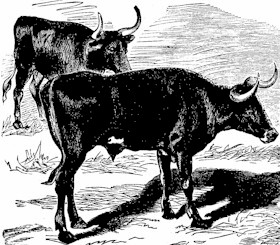|
|
|
Early History of Missouri's Beef Industry
As early as 1836, Texans began driving half wild mustangs into Missouri markets. About that same time, Texas cattle began filtering north also. At first cattle came by several hundreds, thereafter increasing by the thousands annually. The Osage Trace was the main route used for the movement of cattle to northern markets, particularly St. Louis. In those days, St. Louis was as far west as the railroad extended, so it was the first target of the great cattle drives. Not every drive took the same path. In search for grass for the cattle, the drovers generally paralleled where other cattle had grazed in order to keep weight on cattle. As the railroads extended further west, Sedalia became an important cattle town and later, Kansas City took over as Missouri's "Cowtown".
Click here to see a map of Missouri showing the cattle trail routes.

In 1853 Tom Candy wrote an account of the cattle drive into Missouri. "We crossed into Missouri out of the Indian country, near what is now known as Baxter Springs," he wrote. "I sat on my horse every night while we were coming through the Indian country; I was so afraid that something would scare the cattle that I could not sleep in the tent; but we had no stampede."
In 1854 there were about fifty thousand longhorns that had crossed the Red river and were headed for the northern markets. The Shawnee trail was the main route to Kansas City, Westport, and Independence. The Texas settlers called the trail "Texas Road". Sometimes it was just called the "cattle trail".
By 1856, Missourians along the borders of Missouri and Kansas noticed that their cattle were dying of what would be known as the Texas fever. These farmers were becoming alarmed due to all of the infected cattle that were crossing their state. These farmers and cattlemen feared (correctly) these cattle that believed were the cause of "Texas Fever". The cattle in Missouri and Kansas had no resistance to the tick.
By 1861 a statewide ban on Texas cattle was implemented and railroads could not transport them from one county to another. This would generally end the great cattle drives, however, some managed to move cattle into Missouri, but not without paying money (bribes) to pass. Estimates suggest that 200,000 Texas longhorn cattle were moved from Texas to Missouri over a twenty-one year period.

Driving large herds of cattle from Texas to Missouri was a very hard way to make a living. The men who tried to bring cattle north often did not make it and the ones that did seldom tried again.
![]() This
page was designed by Brad Evans and Aaron
Rieder
This
page was designed by Brad Evans and Aaron
Rieder
![]() For
more information, contact Lyndon
N. Irwin
For
more information, contact Lyndon
N. Irwin